Low-Damage Corn Threshing Technology and Corn Threshing Devices: A Review of Recent Developments
Abstract
1. Introduction
2. The Key Technology Status of Corn Threshing
2.1. Effect of Grain Moisture Content on Corn Threshing
2.2. Effect of Mechanical Parameters on Corn Threshing
2.2.1. Effect of Concave Clearance on Corn Threshing
2.2.2. Effect of Feeding Rate on Corn Threshing
2.2.3. Parameter Optimization of Threshing Machine
2.3. Application of Numerical Simulation in the Study of Corn Threshing
2.3.1. Application of Finite Element Method in Corn Threshing Technology
2.3.2. Application of Discrete Element Method in Corn Threshing Technology
3. Development Status of Corn Threshing Device
3.1. Development Status of Tangential Flow Corn Threshing Device
3.2. Development Status of Axial Flow Corn Threshing Device
3.3. Development Status of Tangential–Axial Flow Corn Threshing Device
3.4. Development Status of Intelligent Control System of Corn Combine
4. Conclusions
- The grain moisture content exerted a significant influence on the mechanical properties of corn kernels. The elastic modulus, hardness, tensile strength, and shear strength of corn decreased with the increase in grain moisture content. By selecting the varieties that can match the local light and temperature conditions in the appropriate growth period and determining the suitable planting area of the varieties, it can be guaranteed that the corn had the appropriate grain moisture content during harvest and reduced the crushing rate.
- Numerical simulation technology has become a crucial means in the research of corn threshing technology because of its advantages of a low test cost and not being restricted by season and space. The numerical simulation technology can reveal the stress and strain conditions and movement rules of corn kernels in the process of corn threshing. Moreover, some researchers have developed a 3D discrete element method software for realizing the simulation analysis of the corn threshing process.
- Mechanical grain harvesting is the developing direction of corn harvesting technology. Many research institutions and companies focus on the development of low-breakage corn combine to curtail the damage rate of corn combine by improving the rigid threshing technology or threshing element.
- In the process of mechanical grain harvesting, the rotating speed of the cylinder is the main mechanical reason for kernel breakage. It is a vital method to lower the breakage of corn kernels to optimize the control of the threshing cylinder speed and the adjustment algorithm of the concave clearance. The intelligent control strategy of the corn threshing device combined with the PID control algorithm, deep learning, and other technologies can achieve data acquisition, processing, and adjustment of the device while acquiring a lower damage rate.
Author Contributions
Funding
Institutional Review Board Statement
Informed Consent Statement
Data Availability Statement
Acknowledgments
Conflicts of Interest
References
- Neumann, P.; Wall, J.; Walker, C. Chemical and physical properties of proteins in wet-milled corn gluten. Cereal Chem. 1984, 61, 353–356. [Google Scholar]
- Yang, J.; Li, X.; Xue, Y.; Wang, N.; Liu, W.J. Anti-hepatoma activity and mechanism of corn silk polysaccharides in H22 tumor-bearing mice. Int. J. Biol. Macromol. 2014, 64, 276–280. [Google Scholar] [CrossRef] [PubMed]
- Lee, J.; Lee, S.; Kim, S.-L.; Choi, J.W.; Seo, J.Y.; Choi, D.J.; Park, Y.I. Corn silk maysin induces apoptotic cell death in PC-3 prostate cancer cells via mitochondria-dependent pathway. Life Sci. 2014, 119, 47–55. [Google Scholar] [CrossRef] [PubMed]
- Fernandez, A.; Torres-Giner, S.; Lagaron, J.M. Novel route to stabilization of bioactive antioxidants by encapsulation in electrospun fibers of zein prolamine. Food Hydrocoll. 2009, 23, 1427–1432. [Google Scholar] [CrossRef]
- Shi, M.L.; Zhu, G.Q.; Chen, G.Y.; Xue, L.; Hu, J.R.; Yin, Z.T.; Chen, G.Q. Medicinal value of maize and its industrialization development and application. Food Nutr. China 2004, 12, 23–25. [Google Scholar]
- Zhang, L.N. Study on the Influence of Mechanized Production on Competitiveness of Maize Industry in China. Master’s Thesis, China Agricultural University, Beijing, China, 2017. [Google Scholar]
- Ren, L.J. Is Jilin Golden Corn Belt a crown of glory or a heavy wing? Heilongjiang Grain 2017, 6, 30–33. [Google Scholar]
- Li, S.K.; Wang, K.R.; Xie, R.Z.; Hou, P.; Ming, B.; Yang, X.X.; Han, D.S.; Wang, Y.H. Implementing Higher Population and Full Mechanization Technologies to Achieve High Yield and High Efficiency in Maize Production. Crops 2016, 4, 1–6. [Google Scholar] [CrossRef]
- Wang, K.R.; Li, S.K. Progresses in Research on Grain Broken Rate by Mechanical Grain Harvesting. Sci. Agric. Sin. 2017, 11, 2018–2026. [Google Scholar]
- Liu, X.Z.; Li, M.; Zhang, J.; Chen, R.J.; Fu, H.; Ma, G.M.; Zhou, Y.H.; Zhuang, X.L. The Dehydration and Mechanical-harvesting of Maize Grain: Research Progress. J. Agric. 2022, 7, 64–68. [Google Scholar]
- Li, X.; Pei, X.M. Research status and analysis of corn grain harvesting machinery threshing device. Farm Mach. 2016, 12, 80–83. [Google Scholar]
- Srison, W.; Chuan-Udom, S.; Saengprachatanarug, K.J. Design factors affecting losses and power consumption of an axial flow corn shelling unit. Agric. Nat. Resour. 2016, 38, 421–425. [Google Scholar]
- Yuan, Y.M.; Li, Y.F.; Luan, Y.Z.; Wang, M. Experimental study on geometric characteristics and cracking resistance of maize grains. Test Technol. Test. Mach. 1994, Z2, 30–34. [Google Scholar]
- Yuan, Y.M.; Luan, Y.Z. Experimental study on mechanical properties of maize grains. J. Jilin Agric. Univ. 1996, 4, 75–78. [Google Scholar]
- Srison, W.; Chuan-Udom, S.; Saengprachatanarak, K. Effects of operating factors for an axial-flow corn shelling unit on losses and power consumption. Agric. Nat. Resour. 2016, 50, 421–425. [Google Scholar] [CrossRef]
- Ekstrom, G.A.; Liljedahl, J.; Peart, R.M. Thermal expansion and tensile properties of corn kernels and their relationship to cracking during drying. Trans. ASAE 1966, 9, 556–561. [Google Scholar] [CrossRef]
- Zhang, X.W.; Yi, K.C.; Liu, X.D.; Zhao, X.G. Analysis on the Generating Mechanism and Causes of Stress Cracks in Maize. J. Yangtze Univ. (Nat. Sci. Ed.) 2019, 5, 59–63+67+8. [Google Scholar]
- Feng, H.P.; Mao, Z.H. Experimental study on effects of moisture content, drying temperature and stress crack on mechanical properties of maize. Mach. Cereals Oil Food Process. 2003, 4, 48–50. [Google Scholar]
- Thompson, R.A.; Foster, G.H. Stress Cracks and Breakage in Artificially Dried Corn; US Department of Agriculture: Washington DC, USA, 1963; pp. 6–23.
- Yan, H.L. Study on Mechanical Properties and In-Situ Characteristics of Maize. Master’s Thesis, Jilin University, Changchun, China, 2017. [Google Scholar]
- Wang, Y.G. Design and Experimental Study on Corn Threshing Device with High Moisture. Master’s Thesis, Shandong University of Technology, Zibo, China, 2019. [Google Scholar]
- Singh, S.; Finner, M.; Rohatgi, P.; Buelow, F.; Schaller, M.J. Structure and mechanical properties of corn kernels: A hybrid composite material. J. Mater. Sci. 1991, 26, 274–284. [Google Scholar] [CrossRef]
- Gao, L.X.; Li, F.; Zhang, X.W.; Zhang, Y.L.; Liu, X.; Jiao, W.P. Mechanism of Moisture Content Affect on Corn Seed Threshing. Trans. Chin. Soc. Agric. Mach. 2011, 12, 92–96+42. [Google Scholar]
- Yi, K.C.; Zhu, D.W.; Zhang, X.W.; Yao, Z.H.; Liu, Z. Effect of moisture content on corn grain harvesting mechanization. J. Chin. Agric. Mech. 2016, 37, 78–80. [Google Scholar]
- Yu, J.Y. Measurement and Analysis of the Physical and Mechanical Properties of Corn Ears. Master’s Thesis, Jilin University, Changchun, China, 2014. [Google Scholar]
- Volkovas, V.; Petkevičius, S.; Špokas, L. Establishment of maize grain elasticity on the basis of impact load. Mechanics 2006, 62, 64–67. [Google Scholar]
- Zhang, Y.L.; Gao, L.X.; Liu, H.L.; Li, X.P. Experimental Study on Corn Kernel Shear Crash. J. Agric. Mech. Res. 2007, 5, 136–138. [Google Scholar]
- Li, X.P.; Li, Y.Z.; Ma, F.L.; Gao, L.X. Anti-pressing Properties and Crack Formation Law of Corn Seed. Trans. Chin. Soc. Agric. Mach. 2011, 42, 94–98. [Google Scholar]
- Li, X.P.; Xiong, S.; Geng, L.X.; Ji, J.T. Influence of water content on anti-pressing properties of corn ear. Trans. Chin. Soc. Agric. Eng. 2018, 34, 25–31. [Google Scholar]
- Li, X.P.; Gao, L.X.; Ma, F.L.; Yu, Y.Z.; Zhang, Y.L. Experimental Research of Corn Seed Kernel on the Impacting Damage. J. Shenyang Agric. Univ. 2007, 1, 89–93. [Google Scholar]
- Li, X.P.; Ma, F.L.; Gao, L.X. Dropping impact experiment on corn seeds. Trans. Chin. Soc. Agric. Eng. 2009, 25, 113–116. [Google Scholar]
- Yang, Y.F.; Zhang, Y.L.; Zhang, B.H.; Tong, L.; Gao, L.X. Experimental Study on Static Pressing Typical Corn Seed Kernel. J. Agric. Mech. Res. 2008, 7, 149–151. [Google Scholar]
- Zhao, W.Y. Research on Combined Type of Spiral Bar Tooth Threshing Mechanism For Seed Corn. Master’s Thesis, Northwest A&F University, Yangling, China, 2012. [Google Scholar]
- Zhang, F.W.; Zhao, W.Y.; Han, Z.S.; Liu, J.C.; Yang, X.P.; Dai, F. Experimental Researches on Mechanical Properties of Corn kernels. J. Chin. Agric. Mech. 2010, 3, 75–78. [Google Scholar]
- Qu, H.J. Experiment and Research on adaptability of grain corn Harvester. Master’s Thesis, Shandong University of Technology, Zibo, China, 2013. [Google Scholar]
- Qu, H.J.; Zhang, D.L.; Yang, T.W.; Xu, Z.D. Experimental Research on Corn Threshing Performance Effected by Moisture Content. J. Agric. Mech. Res. 2014, 36, 153–156. [Google Scholar]
- Xiang, M.G.; Zhang, D.L.; Li, C.N.; Bu, L.X.; Cui, M. Analysis of Influence Factor on Corn Threshing Performance. J. Agric. Mech. Res. 2015, 1, 188–191. [Google Scholar]
- Yang, L.Q.; Wang, W.W.; Zhang, H.M.; Li, L.H.; Wang, M.M.; Hou, M.T. Improved design and bench test based on tangential flow-transverse axial flow maize threshing system. Trans. Chin. Soc. Agric. Eng. 2018, 34, 35–43. [Google Scholar]
- Al Sharifi, S.K.A.; Aljibouri, M.A.; Taher, M.A. Effect of threshing machines, rotational speed and grain moisture on corn shelling. Bulg. J. Agric. Sci. 2019, 25, 243–255. [Google Scholar]
- Petkevichius, S.; Shpokas, L.; Kutzbach, H.-D. Investigation of the maize ear threshing process. Biosyst. Eng. 2008, 99, 532–539. [Google Scholar] [CrossRef]
- Xu, L.Z.; Li, Y.M.; Wang, X.R. Research development of grain damage during threshing. Trans. Chin. Soc. Agric. Eng. 2009, 25, 303–307. [Google Scholar]
- Guo, H.J.; Wang, X.M.; Ma, C.; Cao, S.H. A brief discussion on corn harvester with direct grain harvest. Agric. Technol. Serv. 2016, 33, 19. [Google Scholar]
- Wang, S. Design and Experimental Study of Concave for Corn Grain Harvester. Master’s Thesis, Jilin University, Changchun, China, 2020. [Google Scholar]
- Wall, G.L. Performance of a Tangential Feed Threshing Cylinder as Affected by Corn Cob Break-up and Concave Design Parameters. Ph.D. Thesis, McGill University, Montreal, QC, Canada, 1981. [Google Scholar]
- Huang, Q.B.; Du, Z.G.; Yao, H.J.; Lv, X.M.; Xiao, W.D.; Cheng, J.C.; Zhang, X. Analysis of the Factors which Affect Corn Threshing Effect. Xinjiang Agric. Mech. 2018, 2, 8–10. [Google Scholar]
- Bakharev, D.; Pastukhov, A.; Volvak, S.; Sharaya, O. Substantiation of deck parameters of rotary threshing device. In Proceedings of the 18th International Scientific Conference: Engineering for Rural Development, Jelgava, Latvia, 22–24 May 2019. [Google Scholar]
- Bakharev, D.; Pastukhov, A.; Volvak, S.; Kovalev, S. Study of seed corn threshing process. Eng. Rural Dev. 2020, 19, 1036–1041. [Google Scholar]
- Astanakulov, K.; Kodirov, B.; Fozilov, G. Development a New Type Corn-Sheller Machine for Farms in Uzbekistan. Int. J. Appl. Agric. Res. 2014, 9, 115–120. [Google Scholar]
- Steponavičius, D.; Pužauskas, E.; Špokas, L.; Jotautienė, E.; Kemzūraitė, A.; Petkevičius, S. Concave design for high-moisture corn ear threshing. Mechanics 2018, 24, 80–91. [Google Scholar] [CrossRef]
- Fu, J.; Yuan, H.; Zhang, D.; Chen, Z.; Ren, L. Multi-objective optimization of process parameters of longitudinal axial threshing cylinder for frozen corn using RSM and NSGA-II. Appl. Sci. 2020, 10, 1646. [Google Scholar] [CrossRef]
- Chen, D.; Wang, S.M.; Kang, F.; Zhu, Q.Y.; Li, X.H. Mathematical model of feeding rate and processing loss for combine harvester. Trans. Chin. Soc. Agric. Eng. 2011, 27, 18–21. [Google Scholar]
- Szymanek, M. Energy-consumption at sweet corn threshing. TEKA Comm. Mot. Power Ind. Agric. 2008, 8, 241–246. [Google Scholar]
- Steponavicius, D.; Butkus, V.; Kiniulis, V.; Karitonas, T.; Bausa, L.; Puzauskas, E. Influence of inertia momentum of cylinder on power consumption during corn ear threshing. In Proceedings of the 12th International Scientific Conference: Engineering for Rural Development, Jelgava, Latvia, 23–24 May 2013. [Google Scholar]
- Oriaku, E.; Agulanna, C.; Nwannewuihe, H.; Onwukwe, M.; Adiele, I. Design and performance evaluation of a corn de-cobbing and separating machine. Am. J. Eng. Res. 2014, 3, 127–136. [Google Scholar]
- Kiniulis, V.; Steponavičius, D.; Andriušis, A.; Kemzūraitė, A.; Jovarauskas, D. Corn ear threshing performance of filler-plate-covered threshing cylinders. Mechanics 2017, 23, 714–722. [Google Scholar] [CrossRef]
- Kiniulis, V.; Steponavičius, D.; Kemzūraitė, A.; Andriušis, A.; Juknevičius, D. Dynamic indicators of a corn ear threshing process influenced by the threshing-separation unit load. Mechanics 2018, 24, 412–421. [Google Scholar] [CrossRef]
- Saeng-ong, P.; Chuan-Udom, S.; Saengprachatanarak, K. Effects of guide vane inclination in axial shelling unit on corn shelling performance. Agric. Nat. Resour. 2015, 49, 761–771. [Google Scholar]
- Steponavičius, D.; Kemzūraitė, A.; Kiniulis, V.; Zokaitis, K. Analysis of corn ears movement within the threshing crescent using high-speed recording method. J. Meas. Eng. 2017, 5, 240–248. [Google Scholar] [CrossRef]
- Ni, Z.W.; Yang, R.B.; Liu, Y.; Wang, M.; Wang, F.J.; Zhou, X.H. Design and Test of Double Drum Corn Seed Threshing Device. J. Agric. Mech. Res. 2020, 42, 150–154. [Google Scholar]
- Chen, M.Z.; Xu, G.H.; Wang, C.X.; Diao, P.S.; Zhang, Y.P.; Niu, G.D. Design and Experiment of Roller-type Combined Longitudinal Axial Flow Flexible Threshing and Separating Device for Corn. Trans. Chin. Soc. Agric. Mach. 2020, 51, 123–131. [Google Scholar]
- Li, X.; Du, Y.; Guo, J.; Mao, E. Design, simulation, and test of a new threshing cylinder for high moisture content corn. Appl. Sci. 2020, 10, 4925. [Google Scholar] [CrossRef]
- Geng, D.Y.; He, K.; Wang, Q.; Jin, C.Q.; Zhang, G.H.; Lu, X.F. Design and Experiment on Transverse Axial Flow Flexible Threshing Device for Corn. Trans. Chin. Soc. Agric. Mach. 2019, 50, 101–108. [Google Scholar]
- Zhang, Y.C. Design and Test of Single Axial Flow Threshing Drum for Corn Grain Harvester. Master’s Thesis, Jilin University, Changchun, China, 2020. [Google Scholar]
- Liu, L.H. Maize Test Bench and Its Control System for Single Longitudinal Axial Flow Threshing Cylinder. Master’s Thesis, Jilin University, Changchun, China, 2018. [Google Scholar]
- Jin, D.B. Single Longitudinal Flow Corn Combine Thresher Control System. Master’s Thesis, Jilin University, Changchun, China, 2020. [Google Scholar]
- Wang, G.W. Research on compression mechanical properties of corn kernels with finite element method. J. Chin. Agric. Mech. 2016, 37, 117–120. [Google Scholar]
- Li, X.P.; Ma, L. Analysis of Finite Element Method on Dynamic Contact of Corn Ear. J. Syst. Simul. 2017, 29, 67–75. [Google Scholar]
- Zhang, Y.; Li, C.Y.; Fang, Z.D.; Zheng, F. Analysis of Mechanical Characteristic of Maize Based on the FEM. Comput. Simul. 2018, 35, 194–197. [Google Scholar]
- Wang, B.; Wang, J.; Du, D.D. Finite element analysis of dynamic impact damage process of maize kernel based on HyperMesh and LS-DYNA. J. Zhejiang Univ. (Agric. Life Sci.) 2018, 44, 465–475. [Google Scholar]
- Pužauskas, E.; Steponavičius, D.; Jotautienė, E.; Petkevičius, S.; Kemzūraitė, A.J.M. Substantiation of concave crossbar shape for corn ear threshing. Mechanics 2016, 22, 553–561. [Google Scholar] [CrossRef]
- He, K.; Wang, Q.; Geng, D.Y.; Jin, C.Q.; Zhu, J.G.; Zhang, M.Y. Simulation and analysis of flexible threshing cylinder of corn. J. Chin. Agric. Mech. 2018, 39, 53–58. [Google Scholar]
- Hu, B.Y.; Li, Y.M. Simulation Analysis of Ear Collision in Corn Kernel Threshing. Agric. Equip. Technol. 2018, 44, 4–7. [Google Scholar]
- Shahbazi, F.; Shahbazi, R. Mechanical damage to corn seeds. Cercet. Agron. Mold. 2019, 51, 1–12. [Google Scholar] [CrossRef]
- Tao, T.; Wei, X.H. Finite Element Analysis of Maize Seed under Impact Loading with Nail-tooth Corn Thresher. J. Agric. Mech. Res. 2019, 41, 35–39. [Google Scholar]
- Xu, Y.; Sun, Q.C.; Zhang, L.; Huang, W.B. Advances in Discrete Element Methods For Particulate Materials. Adv. Mech. 2003, 33, 251–260. [Google Scholar]
- Zhu, H.; Zhou, Z.; Yang, R.; Yu, A. Discrete particle simulation of particulate systems: A review of major applications and findings. Chem. Eng. Sci. 2008, 63, 5728–5770. [Google Scholar] [CrossRef]
- Jiang, S.Q.; Tan, Y.Q.; Zhang, H.; Yang, D.M. Examples of application of discrete element method in mechanical engineering. In Proceedings of the National Conference on Computational Mechanics of Granular Materials, Zhang Jiajie, China, 16–18 September 2012. [Google Scholar]
- Yu, Y.J.; Zhou, H.L.; Fu, H.; Wu, X.C.; Yu, J.Q. Modeling method of corn ears based on particles agglomerate. Trans. Chin. Soc. Agric. Eng. 2012, 28, 167–174. [Google Scholar]
- Zhou, H.L. The Physical and Mechanical Property Research of Corn Ears and Simulated Analysis of Corn Threshing Progress. Master’s Thesis, Jilin University, Changchun, China, 2018. [Google Scholar]
- Li, Q.L. Research on the Experiment and Simulation Analysis of the Threshing Process of the Collision Style Corn Thresher. Master’s Thesis, Jilin University, Changchun, China, 2018. [Google Scholar]
- Ma, J. The Physical and Mechanical Property Analysis of Corn Ears and Simulation Research on Com Threshing Progress. Master’s Thesis, Jilin University, Changchun, China, 2018. [Google Scholar]
- Yu, Y.; Fu, H.; Yu, J. DEM-based simulation of the corn threshing process. Adv. Powder Technol. 2015, 26, 1400–1409. [Google Scholar] [CrossRef]
- Wang, M.M.; Wang, W.Z.; Yang, L.Q.; Zhang, H.M.; Zhong, D.F. Bench experiment and discrete element simulation analysis of corn threshing process. J. Henan Agric. Univ. 2019, 53, 365–373. [Google Scholar]
- Li, Y.M.; Jia, B.Q.; Xu, L.Z.; Qiao, M.G.; Zhao, Z. Development and experiments on tangential flow threshing and separating device of axial flow combine. Trans. Chin. Soc. Agric. Eng. 2009, 25, 93–96. [Google Scholar]
- Feng, W.; Pang, Y.L.; Li, P.; Cui, J.B.; Zhang, X.F.; Zhan, X.M. Experimental Research on Threshing and Separating Performance of Double-stream Cut Threshing Device. J. Agric. Mech. Res. 2017, 39, 180–184. [Google Scholar]
- T670 Combine. [EB/OL]. Available online: https://www.deere.com/en/harvesting/t670-combine/ (accessed on 21 October 2022).
- Byg, D.M.; Hall, G. Corn losses and kernel damage in field shelling of corn. Trans. ASAE 1968, 11, 164–166. [Google Scholar]
- Yi, S.J. Experimental research on the spike tooth of double axial flow threshing and separating unit. Mach. Des. Manuf. 2006, 5, 88–89. [Google Scholar]
- Li, B.H.; Zhang, Y.F.; Zhang, G.H. Study on Power Consumption about the Axial Flow Threshing and Separating Installation with Helical Blade Plate. J. Agric. Mech. Res. 2006, 12, 165–166. [Google Scholar]
- Xiong, Y.S.; Wang, J.S.; Chen, D.J.; Xu, Z.W.; Hu, H.D. Design and Experiment of Small Combine Harvester with Double Axial Cylinder. Trans. Chin. Soc. Agric. Mach. 2011, 42, 35–38. [Google Scholar]
- Dai, F.; Gao, A.M.; Sun, W.; Zhang, F.W.; Wei, H.A.; Han, Z.S. Design and Experiment Conical Cylinder on Longitudinal Axial Threshing Unit. Trans. Chin. Soc. Agric. Mach. 2011, 42, 74–78. [Google Scholar]
- Dai, F.; Han, Z.S.; Zhao, W.Y.; Zhang, F.W.; Gao, A.M.; Wei, L.J. Design and experiment on threshing and separating unit of plot breeding wheat with double longitudinal axial cylinder. Res. Agric. Mod. 2016, 37, 1015–1020. [Google Scholar]
- Wang, Z.M.; Lv, P.M.; Chen, N.; Ma, G. Study on distribution spectrum of grain connection force and differential-speed threshing device for combine harvester. J. Zhejiang Univ. (Agric. Life Sci.) 2017, 43, 120–127. [Google Scholar]
- Qu, Z. Research on Combined Maize Threshing and Separating Device with Low Damage. Master’s Thesis, China Agricultural University, Beijing, China, 2018. [Google Scholar]
- Axial Flow 4000 Series Combines. [EB/OL]. Available online: https://www.caseih.cn/products/Harvesters/Axial-Flow-4000 (accessed on 21 October 2022).
- Anil, J.; Guruswamy, T.; Desai, S.; Basavaraj, T.; Joshi, A. Effect of cylinder speed and feed rate on the performance of thresher. J. Agric. Sci. 1998, 4, 120–121. [Google Scholar]
- Baruah, D.; Panesar, B. Energy requirement model for a combine harvester, Part I: Development of component models. Biosyst. Eng. 2005, 90, 9–25. [Google Scholar] [CrossRef]
- Wacker, P.; Kutzbach, H.D. State of the Art of Combine Harvesters for grain Harvesting. Harvest Technol. 2003, 58, 234–235. [Google Scholar]
- Rao, S.R.; Chen, S.R.; Shen, L.L.; Liu, C.; Xiao, J. Experiment of Threshing and Separation on Tangential-Double Longitudinal Axial Device. J. Agric. Mech. Res. 2017, 39, 202–206. [Google Scholar]
- Yang, L.Q. Design and Experiment Research Based on Tangential Flow Transverse Axialflow Corn Threshing System. Master’s Thesis, Henan Agricultural University, Zhengzhou, China, 2018. [Google Scholar]
- CR-Series Combines. [EB/OL]. Available online: https://agriculture.newholland.com/en-us/nar/products/combines-and-headers/cr-revelation-combine-harvester (accessed on 21 October 2022).
- Yan, L.J.; Shi, S.B.; Li, X.H.; Sun, X.C. An Auto-control System of Revolution Speed of Threshing Cylinder for Combine Harvester. J. Agric. Mech. Res. 2007, 2, 103–105. [Google Scholar]
- Li, Y.M.; Wang, J.P.; Xu, L.Z.; Tang, Z.; Xu, Z.H.; Wang, K.J. Design and Experiment on Adjusting Mechanism of Concave Clearance of Combine Harvester Cylinder. Trans. Chin. Soc. Agric. Mach. 2018, 49, 68–75. [Google Scholar]
- Omid, M.; Lashgari, M.; Mobli, H.; Alimardani, R.; Mohtasebi, S.; Hesamifard, R. Design of fuzzy logic control system incorporating human expert knowledge for combine harvester. Expert Syst. Appl. 2010, 37, 7080–7085. [Google Scholar] [CrossRef]
- Jiang, G.C. Case AFX8010 axial flow roller combine. Farm Mach. 2003, 11, 57. [Google Scholar]
- Cui, Z.K.; Zhang, H.; Zhou, J.; Di, Z.F.; Wang, X.J. Design and experiment of intelligent corn grain harvester. J. Chin. Agric. Mech. 2019, 40, 26–30. [Google Scholar]
- Zhu, X.L.; Chi, R.J.; Du, Y.F.; Deng, X.J.; Zhang, Z.; Dong, N.X. Design and Experiment of Intelligent Control System for Low Loss Threshing of High Moisture Content Corn. Trans. Chin. Soc. Agric. Mach. 2021, 52, 9–18. [Google Scholar]
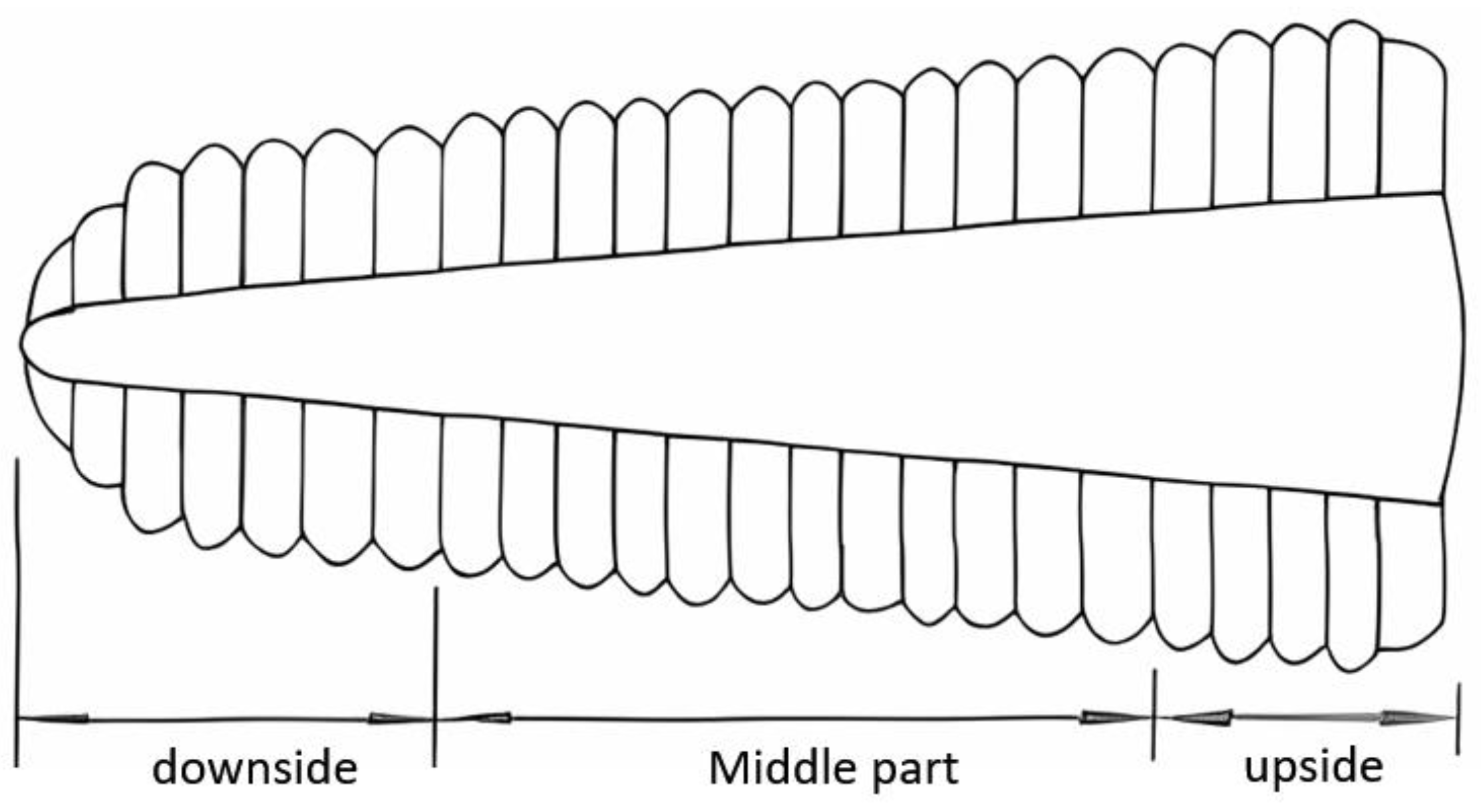
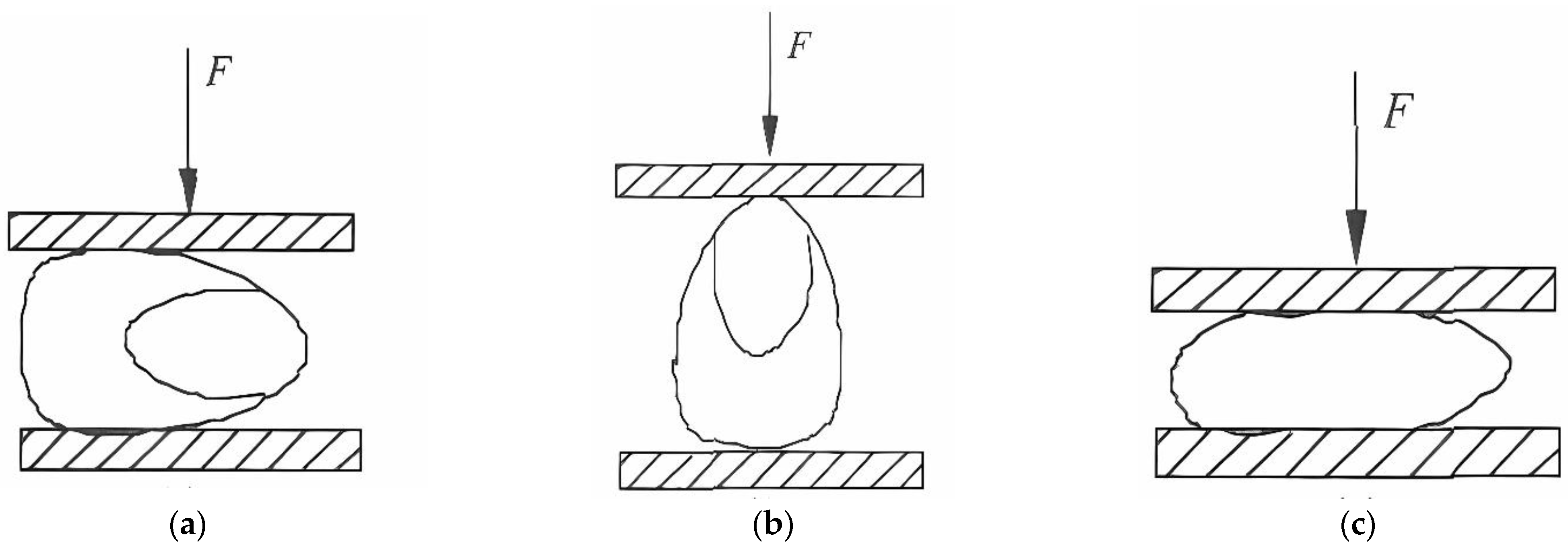


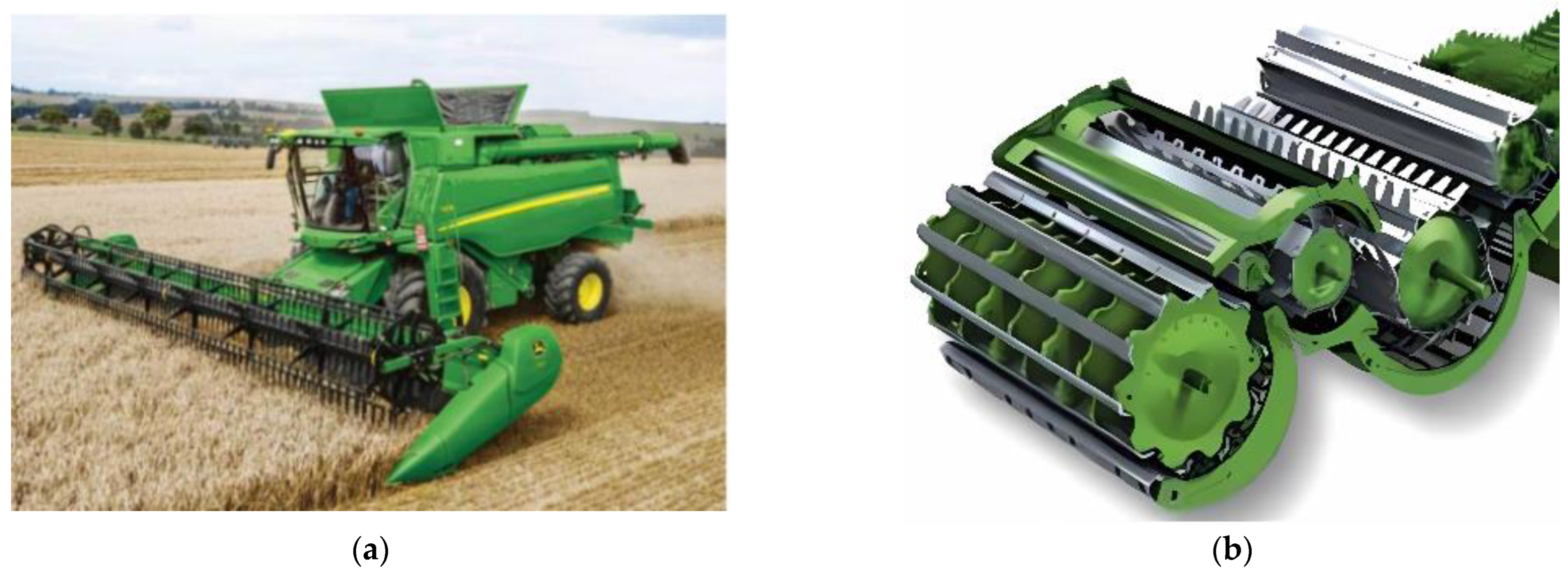


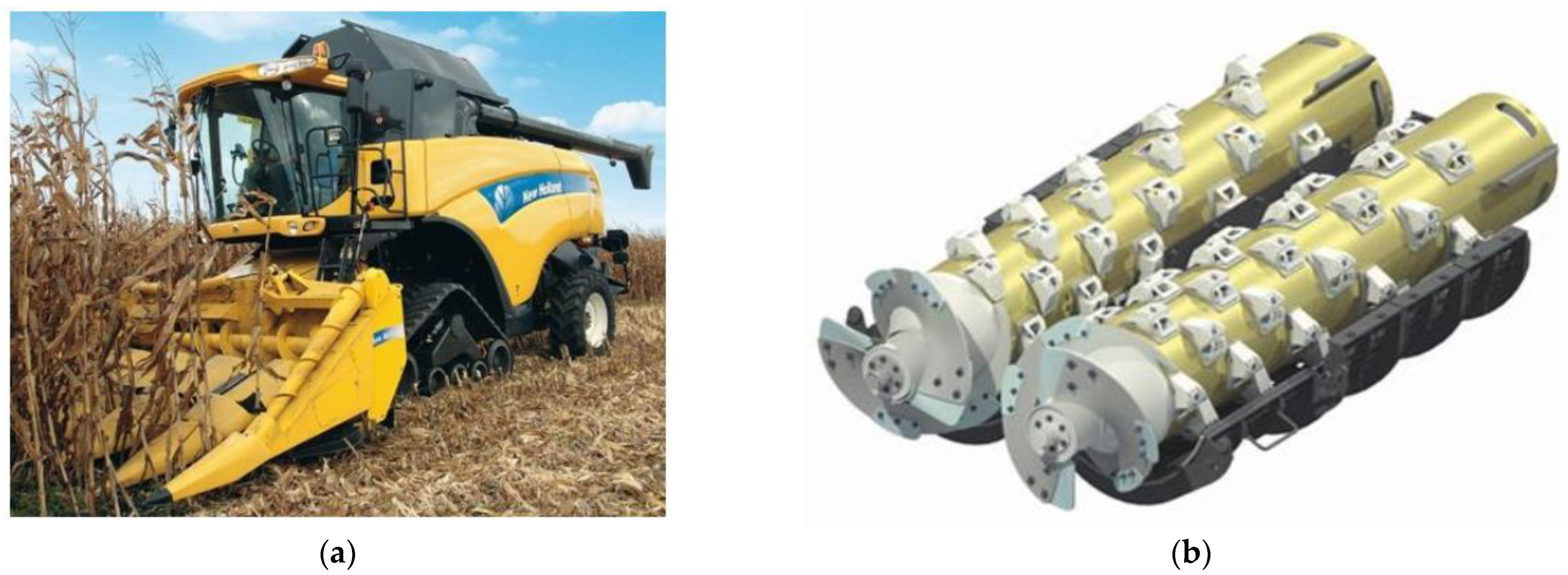
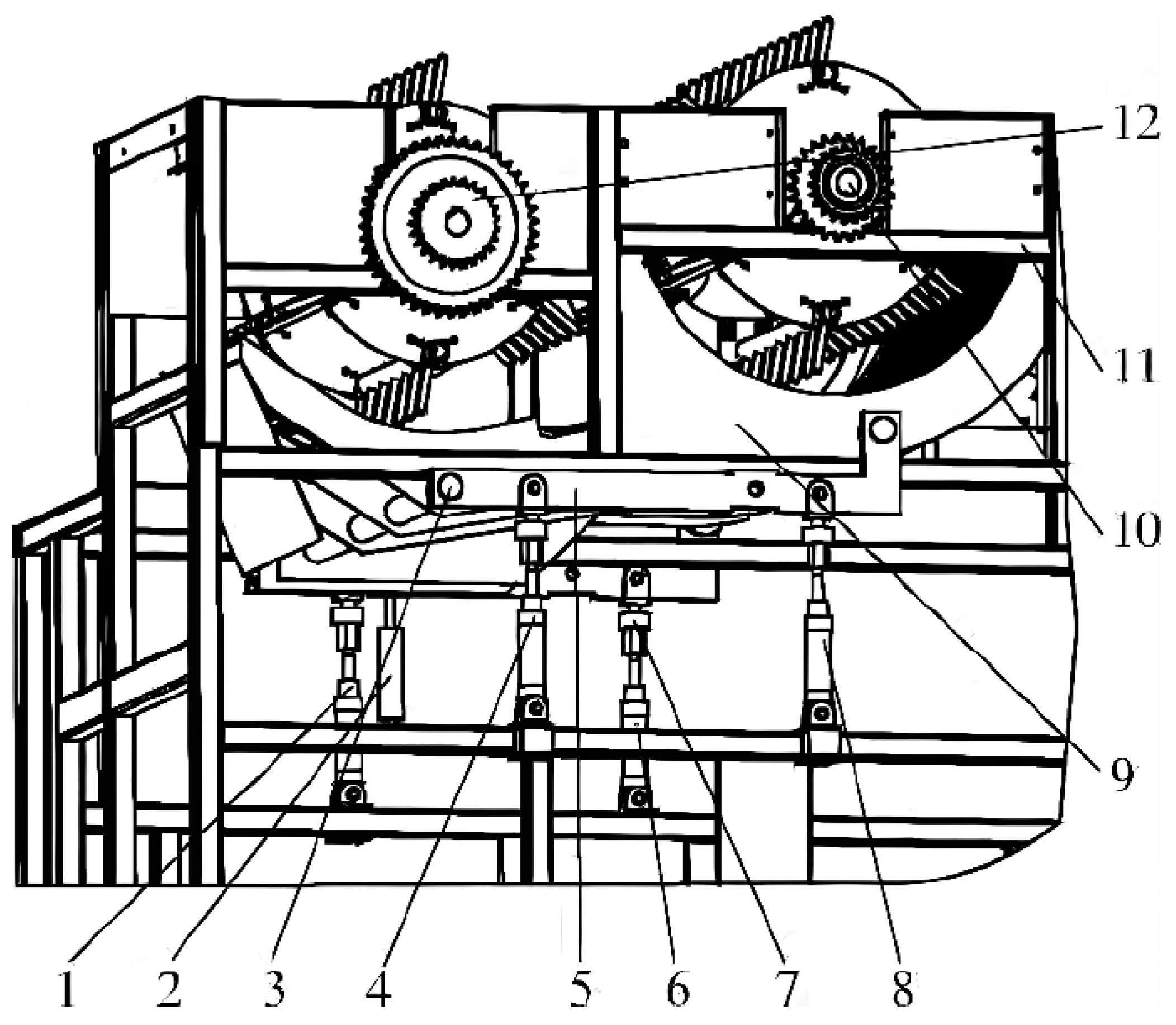


Disclaimer/Publisher’s Note: The statements, opinions and data contained in all publications are solely those of the individual author(s) and contributor(s) and not of MDPI and/or the editor(s). MDPI and/or the editor(s) disclaim responsibility for any injury to people or property resulting from any ideas, methods, instructions or products referred to in the content. |
© 2023 by the authors. Licensee MDPI, Basel, Switzerland. This article is an open access article distributed under the terms and conditions of the Creative Commons Attribution (CC BY) license (https://creativecommons.org/licenses/by/4.0/).
Share and Cite
Li, X.; Zhang, W.; Xu, S.; Du, Z.; Ma, Y.; Ma, F.; Liu, J. Low-Damage Corn Threshing Technology and Corn Threshing Devices: A Review of Recent Developments. Agriculture 2023, 13, 1006. https://doi.org/10.3390/agriculture13051006
Li X, Zhang W, Xu S, Du Z, Ma Y, Ma F, Liu J. Low-Damage Corn Threshing Technology and Corn Threshing Devices: A Review of Recent Developments. Agriculture. 2023; 13(5):1006. https://doi.org/10.3390/agriculture13051006
Chicago/Turabian StyleLi, Xinping, Wantong Zhang, Shendi Xu, Zhe Du, Yidong Ma, Fuli Ma, and Jing Liu. 2023. "Low-Damage Corn Threshing Technology and Corn Threshing Devices: A Review of Recent Developments" Agriculture 13, no. 5: 1006. https://doi.org/10.3390/agriculture13051006
APA StyleLi, X., Zhang, W., Xu, S., Du, Z., Ma, Y., Ma, F., & Liu, J. (2023). Low-Damage Corn Threshing Technology and Corn Threshing Devices: A Review of Recent Developments. Agriculture, 13(5), 1006. https://doi.org/10.3390/agriculture13051006




